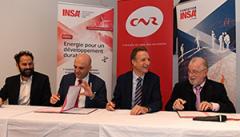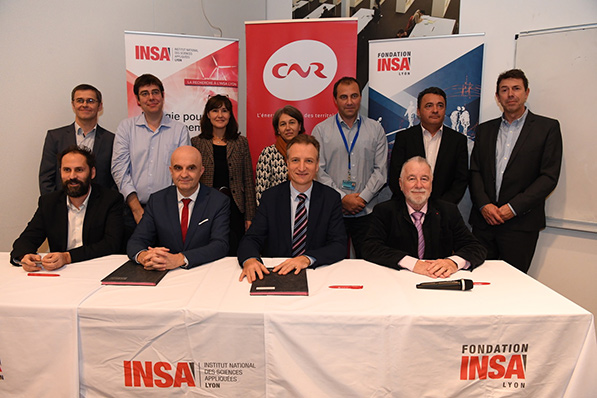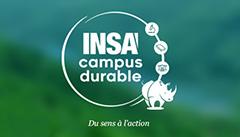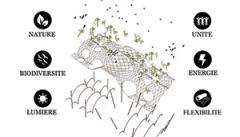
Entreprises
The Compagnie Nationale du Rhône and INSA Lyon are launching a research chair: ‘Water, renewable energy and sustainable production’.
Didier Lhuillier, Managing Director of the Compagnie Nationale du Rhône (CNR), Éric Maurincomme, Director of INSA Lyon, and Jean Guénard, Chair of the INSA Lyon Foundation, have signed a sponsorship agreement for the creation of a scientific research chair dedicated to renewable energy and sustainable development.

The work carried out under this new chair will focus more specifically on improving prediction methods and optimising production data (digital, AI, etc.) in hydroelectricity. This new five-year partnership strengthens the existing collaboration and links between CNR and the Lyon engineering school. Supported by the INSA Lyon Foundation, it illustrates the open approach to innovation taken by CNR as part of its strategy. The signing took place on INSA premises in Villeurbanne, in the presence of several students, lecturers, researchers and CNR employees.
The geographical proximity and complementary nature of their work have naturally led CNR and INSA Lyon to collaborate for many years on scientific topics related to energy and the environment. The desire to give a broader framework to their partnership and the ambition to accelerate technological responses to the issue of energy transition are naturally leading them to combine their respective expertise within the INSA Lyon Chaires Enjeux programme, supported by its Foundation and Research Department.
A chair aimed at accelerating technological responses to the issue of energy transition
Forecasters predict 10 to 40% less water on the Rhone by 2050 to 2100 and episodes of extreme climate change increasing periods of drought and floods strongly impacting hydroelectric production. The partnership with INSA and the launch of the Chair will help strengthen CNR's adaptability to global warming and the increasing scarcity of water resources.
In close collaboration with the CNR teams, Marc Clausse, Professor, researcher and assistant to the Director of Research at INSA Lyon in charge of ‘Energy for sustainable development’ is the holder of this Chaire Enjeux. The specific features of this chair are to bring together scientific skills from several laboratories to conduct research on highly multidisciplinary industrial issues and to integrate societal and economic issues. The two key themes are:
- ‘Corrosion and fatigue on hydromechanical works’;
- ‘Optimisation and predictive maintenance of power generation facilities based on big data’.
The research group draws on complementary skills in materials, mechanics, chemistry and IT to support CNR's strategic vision for the smart and efficient conversion of hydraulic energy into electrical energy.
Thanks to the scientific excellence of INSA, this partnership will enable CNR to improve:
- its predictive maintenance applied to material fatigue and corrosion;
- its digital transformation: by making progress in AI and Big Data to improve the analysis of its production data and the operation of its plants.
The CNR INSA Lyon Chair, supported by the INSA Lyon Foundation, is part of one of the five issues that structure research at INSA Lyon - ‘Energy and Sustainable Development’. This issue, in line with the national research strategy, itself consistent with that of the European Union, aims to respond to the challenges of ‘Efficient management of resources and adaptation to climate change’ and ‘Clean, secure and efficient energy’.
Innovation and R&D at the heart of CNR's strategy
CNR is a laboratory company for the energies of the future, shaping the European energy landscape of tomorrow at the local level.
In 2015, through its ‘CNR 2020’ corporate strategy, it has committed itself to becoming a laboratory company for the energies of the future, with a twofold objective:
- Putting innovation at the heart of the company culture. To this end, CNR launched its ‘Innov'action’ platform in 2016, which enables the creativity of each of its employees to be brought to the fore and valued. Since its creation, it has collected nearly 350 proposals.
- Committing CNR to a comprehensive and open innovation process in order to participate in the emergence of new technologies and industrial sectors, and to create new sources of growth, in partnership with the world of research and education.
This strategy focuses on the development of new renewable energies (green hydrogen, storage, smart grids, electric mobility, etc.), operational energy management, strengthening CNR's industrial excellence, the environment and biodiversity, and agriculture.

INSA Lyon
INSA Campus Durable
Du sens à l'action
« On ne se réveille pas responsable du jour au lendemain. Être responsable passe par une volonté, puis de nombreuses actions qui au fil du temps, prennent la forme d’une démarche plus globale. On ne devient pas non plus responsable si on est seul.
Une démarche responsable se construit à plusieurs. »
Vous voulez savoir ce que fait l'INSA en matière de Développement Durable et Responsabilité Sociétale (DDRS) ?
Rendez-vous à la Bibliothèque Marie Curie, jeudi 15 novembre après-midi, pour découvrir les projets et actions en cours tant dans la formation, la recherche que dans les services et les associations étudiantes.
Cette demi-journée a pour objectif de donner l'envie d'agir dans un écosystème propice à l'expérimentation.
Organisateur de l'événement, le comité de pilotage DDRS de l'INSA s'engage quant à lui à accompagner techniquement et financièrement toutes les idées nouvelles qui contribueront à donner du sens à l’action.
Évènement ouvert à tous les étudiants et tous les personnels (sur autorisation)
Additional informations
Keywords (tags)

Formation
Ingénierie du futur : coup de cœur du jury pour l’équipe INSA Lyon-ENSAL
EPIPLEO, c’est le nom du projet porté par des étudiants de l’INSA Lyon et de l’ENSAL (école nationale supérieure d’architecture de Lyon) dans le cadre du prix de l’ingénierie du futur 2016. Leur proposition : construire une structure d’accueil pour une communauté urbaine flottante, et permettre aussi la reconnexion des villes avec leurs fleuves.
EPIPLEO, cela veut dire « un voyage à la surface de l’eau » en grec et c’est ce qu’une équipe pluridisciplinaire et multinationale INSA Lyon-ENSAL a fait vivre au jury du prix de l’ingénierie du futur 2016. Récompensé du prix « coup de cœur » lors de la 10e édition de ce concours, l’équipe a pu exposer son projet au Ministère de l’Environnement, de l’Energie et de la Mer, dans le cadre d’une compétition qui récompensait les ingénieurs innovants au service de la mobilité et de l’économie circulaire.
Avec EPIPLEO, il s’agissait pour Antonin Moyne, Marie Préaut, Krystel Richard, Nicolas Cloutier et Yuanmei Kan de proposer une alternative aux zones urbaines en valorisant et utilisant les fleuves. La jeune équipe a imaginé une structure fluviale capable d’accueillir une communauté urbaine qui pourrait être autonome, en mesure de produire des ressources énergétiques alimentaires tout en dynamisant certains aspects économiques et écologiques.
« L’idée ici n’est pas de favoriser l’autarcie mais plutôt d’offrir une opportunité de résilience sur les bords du fleuve, ce qui permettrait à des urbains de subvenir à certains de leurs besoins tout en profitant des connexions que la ville leur offre. On propose de composer un morceau de ville sur les rives du Rhône ou de la Saône par exemple, en minimisant l’empreinte au sol et l’impact sur l’environnement » expliquent Antonin Moyne, élève-ingénieur au département Génie Civil et Urbanisme de l’INSA Lyon.
Souple, aérienne, auto-suffisante en énergie et berceau de biodiversité, cette structure flottante baptisée EPIPLEO a pour intérêt de favoriser un mode de vie durable, évolutif selon les besoins de ses habitants.
« Nous avons opté pour des ancrages ponctuels de type arceaux et ducs d’albe, qui permettent un raccordement aux réseaux urbains, d’eau et d’électricité notamment, pour pallier aux éventuels problèmes d’auto-suffisance. On a imaginé des pontons flottants pour permettre la circulation des usagers vers l’ensemble des bâtiments, et une grande résille métallique pour recouvrir l’ensemble, qui va tirer profit du soleil et du vent pour produire de l’énergie » précise Marie Préaut, étudiante en double-cursus architecte-ingénieur à l’INSA Lyon et l’ENSAL.
Une image de la ville de demain qui a séduit le jury du prix de l’ingénierie du futur 2016, saluant au passage la collaboration entre ingénieurs et architectes autour de ce projet.
Additional informations
Pages
- « first
- ‹ previous
- 1
- 2
- 3

